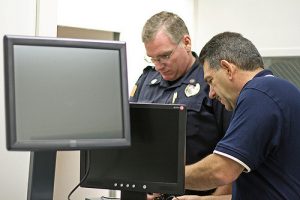
Scientific concepts underpinning CVSA technology can help law enforcement professionals understand—and trust—the results of their interviews. Image Source: Flickr user my_southborough.
Recent advances in law enforcement technology abound, which can sometimes make officers wary about whether these innovations really work. One newer technological advancement is the Computer Voice Stress Analyzer (CVSA), which makes it possible to identify signs of stress in a subject’s voice when they are undergoing questioning. The technology analyzes a visual representation created by the subject’s voice, which is known as a CVSA chart or a voice graph.
While the idea is certainly intriguing, it may still leave many law enforcement professionals with questions. What can be seen on the chart that cannot be heard in the subject’s voice? And are the changes really indicative of deception? How do physiological changes resulting from stress translate into the complex diagrams that are analyzed with CVSA technology? In order to answer these questions and reinforce trust in the solid scientific underpinnings of this technology, it is helpful to explore how key physics and biology concepts relate to what you see on the CVSA chart.
Introduction to Sound Waves
The data on the CVSA chart is a visual representation of sound waves produced by the voice of the subject undergoing questioning. Remember from introductory physics there are several measurements that can be used to characterize sound waves, including amplitude and frequency.
If you look at a CVSA chart or any other graph of a sound wave, the amplitude is the height of the sound wave. That height serves as a visual representation of the intensity or volume of the sound. Tall waves correspond to loud sounds, and short waves correspond to lower volumes; if the amplitude does not reach a certain threshold height, the sound will not be audible at all. When you record a subject responding to questions, the most obvious shifts in their voice will translate directly into amplitude changes on the voice chart. For instance, the amplitude will increase if the subject goes from whispering to yelling.
In relation to CVSA charts, the other relevant element of the sound wave is its frequency. Essentially, frequency is a measurement of the rate at which a particular wave repeats. Sometimes referred to as pitch, frequency is measured in Hertz (Hz).
Relating Sound Waves to the Human Voice
The CVSA measures both these components of the human voice: the amplitude modulation (AM), which is audible, and the frequency modulation (FM), which is inaudible.
Air passing from the lungs to the throat to the mouth as a person speaks produces a glottal tone. The audible (AM) sound then rises from this glottal tone, and the vibration produces formant frequencies. Together, the glottal tone and formant frequencies are responsible for the audible portions of human speech.
At the same time, muscles in the body vibrate slightly as a person speaks, a phenomenon known as a physiological tremor or muscle micro-tremor (FM). Although these oscillations are too small to be detected by the human ear alone, CVSA charts do capture these wave frequency changes.
Voice Changes Under Stressful Conditions
Under conditions of relaxation, human muscles vibrate at a standard rate, so the FM component you see on a voice graph is highly predictable when the speaker is having a casual chat. However, in a more stressful situation, the person’s muscles will start to tighten up, and the muscle vibrations will slow down and eventually stop completely. As a result, the FM (inaudible) component of the voice will decrease until it is lost altogether.
It is not possible to hear the FM component disappear, since the FM component is inaudible to begin with, and the AM component continues at the same level as a person continues to talk. However, the difference is apparent on the CVSA chart—when the FM component disappears from a person’s voice, it also disappears from the chart.
It is important to note that scientific studies have highlighted a close association between stress and deception. Therefore, by identifying and analyzing changes in the physiological tremor, CVSA technology can provide a scientifically-based indication of whether a subject is telling the truth or being deceptive. However, it should be further noted that specific protocols and interview techniques must be adhered to by CVSA examiners in order to achieve accurate examination results. A failure to strictly adhere to CVSA examination protocols, best practices, and interview techniques could potentially impact the outcome of an examination. Based on the technical requirements that must be fulfilled in order to conduct a proper CVSA examination, it is easy to appreciate why each CVSA examiner must undergo initial certification training and thereafter regular recertification training.
Computerized Analysis of Voice Charts
In the end, the rigorous data analysis is left to the computer. Instead of having an examiner provide a subjective reading of a voice chart, the data is analyzed by an objective computerized system, thereby ensuring the reliability and repeatability of the results. However, when it comes to trusting the accuracy of CVSA technology, it can be reassuring for law enforcement officials to understand the science behind the charts.
As a law enforcement professional, your responsibility is to question the subject in a way that produces an informative voice chart. With the right training, you can utilize multiple questioning formats to obtain voice charts that highlight evidence of deception—even if you can’t hear it yourself.
Please reach out to us at NITV Federal Services to learn more about our CVSA systems and training programs.
